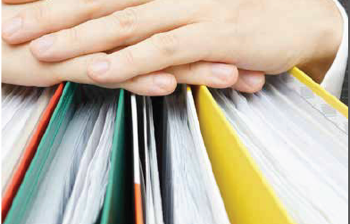Please download this article as a PDF
How to register for and file your self-assessment tax return.
A guide to registering for self-assessment
How to register for and file your self-assessment tax return.
If you’ve never had to complete a self-assessment tax return, the first time can be daunting. But don’t worry: we’ll demystify the process in this article. And if you have completed one before, this guide might still teach you a thing or two about doing your self-assessment better.
What exactly is self-assessment?
Self-assessment is the way millions of people in the UK report and pay their taxes. Specifically, 11.7 million people filed their tax return via self-assessment for the 31 January deadline in 2023.
As the name suggests, self-assessment is all about the taxpayer assessing their own tax liabilities by telling HMRC about their financial activities and income via form SA100. HMRC then uses that reported income to work out how much tax and National Insurance contributions (NICs) you need to pay.
This is in stark contrast to employees, who have their income tax and NICs automatically deducted through the PAYE system — this doesn’t happen for self-employed workers, or for some other sources of income, such as dividends, pensions or income from savings and investment, which is again where self-assessment comes in.
Who has to register?
In general, self-assessment is due for anyone who receives income that is not taxed at source.
So, in the case of a sole trader, because your income received through invoices does not have NICs or income tax subtracted, you must tell HMRC about your income, even if it turns out that you don’t owe any tax.
Income from abroad, income from rental properties, investment income, dividends from your limited company — it all has to be reported via self-assessment.
Employees who earn over £100,000 also have to register for self-assessment. This is because once you make above this amount, your personal allowance changes. HMRC requires people in this category to file a self-assessment tax return so they can ensure the correct tax has been paid.
What about side hustles?
Freelancing on the side is an increasingly popular way of supplementing income nowadays. You might have reporting duties if you do this and earn more than the trading income allowance.
This allowance allows you to make up to £1,000 from one or more trades in a tax year without having to inform HMRC about it, subject to certain conditions.
Be aware that the allowance applies to gross income, which is your overall income before you remove expenses.
When to register
Before you can file a tax return, you need to register for self-assessment with HMRC by 5 October following the tax year you’re filing for. As an example, if you need to file for the 2022/23 tax year for the first time, you should register by 5 October 2023.
If you miss the deadline, you may have to pay a fine. The good news is that you’ll never have to register again — unless you tell HMRC you no longer need to file a tax return.
Once you’ve registered, you have until 31 October after the tax year in question to file a paper return, but in all honesty, you’re far better off filing online. However, if you have partnership or trust income, or are non-resident, you can’t file online — your easiest option is to use an accountant as they’ll be able to file for you using software.
There’s no worry about your return getting lost in the post, the tax you owe is automatically calculated based on what you’ve entered into the form, and you can check your account at any time for mistakes.
Plus, the deadline for online filing is later — the 31 January that follows the tax year in question (in our example above, 2024). This is also the date at which you need to pay any tax you owe, lest you receive a financial penalty.
What you’ll need when registering
Registering is actually relatively straightforward. You’ll just need to supply some personal information, like your full name and date of birth, a phone number, email address, and National Insurance number.
In return, you’ll get a unique taxpayer reference (UTR) number through the post that HMRC will use to identify you.
Filing your return
Once you’ve registered for self-assessment, it’s time to file your tax return. Watch out for these common mistakes:
- Missing or incorrect UTR/National Insurance number
Accuracy is key when it comes to tax returns, and that begins with your identification numbers. You’d be surprised at how many people make a mistake at the first hurdle.
- Incorrect figures and incomplete information
The last thing you want to do is under-report your income and incur a penalty. The second-to-last thing you want to do is over-report and chase HMRC for a refund. Get your figures right the first time by checking and double checking them.
- Ticking the wrong boxes
To prevent mistakes and unnecessary delays, make sure you’re ticking the correct boxes when completing your self-assessment tax return.
- Over- or under- claiming allowable expenses
As a sole trader, landlord or self-employed individual, you can claim a range of allowable expenses for some costs and expenses. Make sure you include them on your tax return — their value can be deducted from your pre-tax profit, leaving you with a smaller sum that HMRC applies a tax charge on, and thus a smaller tax bill.
But make sure you’re not over-claiming allowable expenses — they must be made “wholly and exclusively” for trade to be allowable.
- Missing some sources of income
Deliberately missing out earnings from your tax return is called underreporting, which is tax evasion. Mistakenly missing sources of income won’t be punished as harshly, but save yourself the headache and report all of your income.
- Leaving your tax return until last minute
Leaving your tax return until the week before the deadline can cause serious problems if you realise you don’t have all the financial records you need to complete it at hand. Late filings also come with an automatic £100 penalty and interest on any payment due.
Speak with us
Self-assessment is complicated, especially for the uninitiated and those with particularly complex and numerous revenue streams.
Don’t get caught out: hire an accountant for a fraction of the cost of what you might have to pay if you get your tax return wrong.
Get in touch for support with self-assessment.




